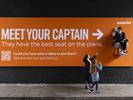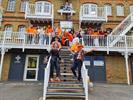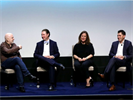Paul Holmes 08 Jul 2003 // 11:00PM GMT
The start of the Anglo-American assault on Iraq presented public relations professionals with a classic Jo Moore moment. Moore was the British government public information officer who lost her job after telling her boss that the day after September 11, 2001, was a good day to make any announcement that might draw a negative reaction. By that logic, any company that planned to fire its CEO, or restate its earnings, had a rare opportunity last week. With the war hogging all the media’s attention, all but the worst corporate news would be ignored.
But what if you had good news, and you couldn’t put it off? That was the challenge facing UPS last week, as it prepared to unveil its new corporate identity. With a new visual identity scheduled to make its debut on 88,000 vehicles and the uniforms of 360,000 UPS employees, as well as a fleet of airplanes and a host of buildings, postponing the announcement was not an option.
And so UPS—working with longtime public relations agency Edelman—went ahead with its announcement on schedule, although it made some adjustments, focusing more on the internal audience, and canceling some international events.
The UPS brand is one of the most visible on the planet. During the course of a year, UPS touches the doorstep of 98 percent of the homes in America and reaches customers in more than 200 additional countries. The logo appears on more than 88,000 vehicles, 257 large jet aircraft, 1,700 facilities around the world, 70,000 drop-off and retail access points, more than 1 million uniform pieces and more than 3 billion packages annually.
UPS worked with Interpublic’s Futurebrand unit (now part of Weber Shandwick Worldwide) on the new identity, starting work on the project two years ago.
The new look represented first redesign in more than 40 years of the company’s famous shield logo, a move intended to reflect the “significant broadening of capabilities that has occurred in recent years as the company expanded across the globe and introduced a portfolio of new supply chain services.” While the company will continue to use the distinctive color brown the logo change includes elimination of the package with a string bow atop the shield. (UPS has not accepted packages tied with strong for several decades, because the string can get caught in high-speed sorting machinery.)
The visual changes will not be restricted to the logo alone. To further communicate the global reach and expanding capabilities of UPS, the phrase “Synchronizing the World of Commerce” will become part of the design of the company’s aircraft and familiar brown package cars. New advertising also will include the “synchronizing commerce” theme.
“UPS is a vastly different company today than most people realize,” said UPS Chairman and CEO Mike Eskew. “Today we are bringing our look up to speed with our capabilities. Package delivery is and will remain the foundation of our business at UPS. But as we expand our capabilities and broaden the solutions we bring to our customers, we felt it was the right time to make our logo reflect the company’s evolution.”
UPS has been developing and acquiring new capabilities to broaden the global package delivery options it provides its customers. Today, it offers freight services by any mode of transportation, international trade management, customs brokerage, consulting and supply chain management, financial services and e-commerce solutions. In addition, UPS has dramatically expanded its retail presence through the acquisition of Mail Boxes Etc.
Says Eskew, “We believe that ‘synchronized commerce’ is the next evolution of global commerce, where the three flows of trade—goods, information and funds—are seamlessly connected to benefit businesses worldwide. Our capabilities give UPS a unique opportunity to lead this evolution, and our strong brand gives us a great foundation on which to move forward.”
According to Eskew, UPS had planned to unveil the new logo today at events around the world, but significantly scaled back on those plans as a result of current events in the Middle East.
Public relations agency Edelman began detailed scenario and contingency planning in October 2002, and stepped up its efforts on March 17, when President Bush announced his 48-hour ultimatum to Iraq’s President Saddam Hussein.
Edelman, which has represented UPS since 1988, was selected in December 2002 as lead agency to help UPS manage the announcement of what is one of the largest corporate transformations ever. In addition to employee and customer events in 30 major cities worldwide, Edelman planned for a major external “splash” that would trumpet UPS’s first logo change in more than four decades. The global campaign included heavy concentration on media relations to support external launch events in New York, Canada, Asia, Europe and Latin America.
“World events over the course of the past week caused a dramatic pull-back on 25 of the global launch events, but didn’t dissuade UPS from moving forward with another significant milestone in the company’ s 95-year history,” says Michael Morley, vice chairman at Edelman and one of the key players in the firm’s UPS relationship.
Eskew acknowledged the impact of world events on the announcement when he addressed employees personally, pausing to pay his respects to the more than 1,000 UPS military reservists who have been called into active duty.
Although media outreach was scaled back, the PR effort resulted in print news coverage to date in The Wall Street Journal, New York Times, Chicago Tribune, Financial Times and USA Today and across major wire services including Associated Press, Bloomberg and Reuters. CEO Mike Eskew appeared on CNBC’s Power Lunch program and on CNNfn on Tuesday, and conducted numerous radio and business magazine interviews.
Pre-packaged video footage of the new UPS brand logo on company assets, including package cars and aircraft, appeared on local TV news outlets in the U.S. from Seattle, where the company was founded in 1907, to Atlanta, where UPS is headquartered today.
Edelman offices in Atlanta, Brussels, Buenos Aires, Chicago, London, Mexico City, Miami, Milan, Montreal, New York, Paris, Sao Paulo and Toronto actively participated in planning, adapting and executing public relations activities that were both sensitive to and appropriate for regional differences.


































.jpg)

















